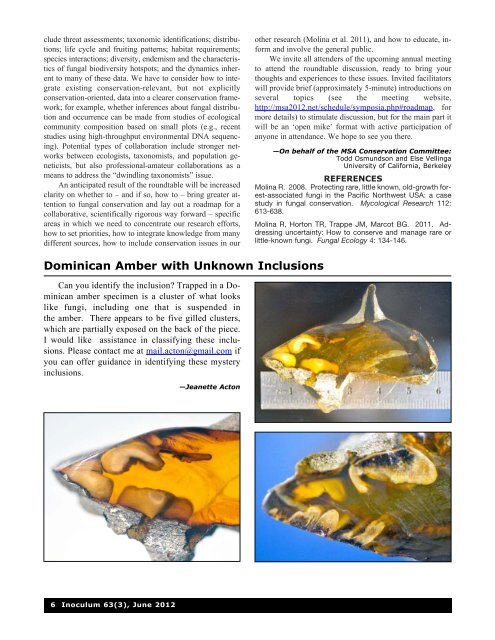Inoculum 63(3) - Mycological Society of America
Inoculum 63(3) - Mycological Society of America
Inoculum 63(3) - Mycological Society of America
You also want an ePaper? Increase the reach of your titles
YUMPU automatically turns print PDFs into web optimized ePapers that Google loves.
clude threat assessments; taxonomic identifications; distributions;<br />
life cycle and fruiting patterns; habitat requirements;<br />
species interactions; diversity, endemism and the characteristics<br />
<strong>of</strong> fungal biodiversity hotspots; and the dynamics inherent<br />
to many <strong>of</strong> these data. We have to consider how to integrate<br />
existing conservation-relevant, but not explicitly<br />
conservation-oriented, data into a clearer conservation framework;<br />
for example, whether inferences about fungal distribution<br />
and occurrence can be made from studies <strong>of</strong> ecological<br />
community composition based on small plots (e.g., recent<br />
studies using high-throughput environmental DNA sequencing).<br />
Potential types <strong>of</strong> collaboration include stronger networks<br />
between ecologists, taxonomists, and population geneticists,<br />
but also pr<strong>of</strong>essional-amateur collaborations as a<br />
means to address the “dwindling taxonomists” issue.<br />
An anticipated result <strong>of</strong> the roundtable will be increased<br />
clarity on whether to – and if so, how to – bring greater attention<br />
to fungal conservation and lay out a roadmap for a<br />
collaborative, scientifically rigorous way forward – specific<br />
areas in which we need to concentrate our research efforts,<br />
how to set priorities, how to integrate knowledge from many<br />
different sources, how to include conservation issues in our<br />
Dominican Amber with Unknown Inclusions<br />
Can you identify the inclusion? Trapped in a Dominican<br />
amber specimen is a cluster <strong>of</strong> what looks<br />
like fungi, including one that is suspended in<br />
the amber. There appears to be five gilled clusters,<br />
which are partially exposed on the back <strong>of</strong> the piece.<br />
I would like assistance in classifying these inclusions.<br />
Please contact me at mail.acton@gmail.com if<br />
you can <strong>of</strong>fer guidance in identifying these mystery<br />
inclusions.<br />
6 <strong>Inoculum</strong> <strong>63</strong>(3), June 2012<br />
—Jeanette Acton<br />
other research (Molina et al. 2011), and how to educate, inform<br />
and involve the general public.<br />
We invite all attenders <strong>of</strong> the upcoming annual meeting<br />
to attend the roundtable discussion, ready to bring your<br />
thoughts and experiences to these issues. Invited facilitators<br />
will provide brief (approximately 5-minute) introductions on<br />
several topics (see the meeting website,<br />
http://msa2012.net/schedule/symposia.php#roadmap, for<br />
more details) to stimulate discussion, but for the main part it<br />
will be an ‘open mike’ format with active participation <strong>of</strong><br />
anyone in attendance. We hope to see you there.<br />
—On behalf <strong>of</strong> the MSA Conservation Committee:<br />
Todd Osmundson and Else Vellinga<br />
University <strong>of</strong> California, Berkeley<br />
REFERENCES<br />
Molina R. 2008. Protecting rare, little known, old-growth forest-associated<br />
fungi in the Pacific Northwest USA: a case<br />
study in fungal conservation. <strong>Mycological</strong> Research 112:<br />
613-<strong>63</strong>8.<br />
Molina R, Horton TR, Trappe JM, Marcot BG. 2011. Addressing<br />
uncertainty: How to conserve and manage rare or<br />
little-known fungi. Fungal Ecology 4: 134-146.
















